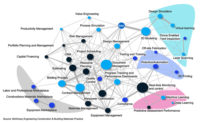Construction CIOs on BIM, BYOD and Emerging Technologies
I had the privilege of moderating a panel of CIOs at ENR's FutureTech Conference in mid-December, held in San Francisco. For those of you unfamiliar with conference, it is a key gathering of technology leaders, expert technology users, and others looking to learn and share knowledge about leveraging technology in AEC firms. The panel is an open dialogue with CIOs on their challenges—keeping the lights on, satisfying internal users, and testing new technologies and practices, to name just a few issues.
Here are some of the insights that the panelists shared.
BIM Successes and Challenges
BIM maturity is always a hot topic at the conference and the CIOs shared some particularly important insights. There is a clear interest in having a better up front dialogue with Owners to better understand the end point facility management systems and their data requirements. Given financial and time constraints, CIOs struggle with how to get their teams to input more data into BIM models with more consistency and one CIO is actively trying to apply data governance techniques to BIM data modeling. They see more opportunity to resolve collisions collaboratively and quickly, and believe that ultimately BIM's return on investment will come through less re-work, improved safety, and completing development ahead of schedule. There was encouraging news to hear Mark Cervenka from Texas A&M Health Sciences Center discuss his adoption of BIM for modeling and the COBie [Construction Operations Building Information Exchange] specification for data and his goal to integrate the two in 2012.
This was a unique panel with technology leads from an architecture, contractor, and trade firm as well as an owner responsible for facilities management. For the most part, we didn't see these CIOs laying blame on their colleagues on BIM integration and adoption issues, although there were a good number of contractor CIOs admitting they needed to rebuild models during constructiion on a consistent basis. This group, along with members of the audience, agreed that a BIM Execution Plan is key to insure that all parties develop a shared understanding of the BIM directives for the project.
Consumerization of IT
A challenge to all CIOs in and out of construction is how to respond to the consumerization of IT or the drive to allow users to BYOD (bring your own device). It was easy to visualize an industry in transformation as half the panel participants were firmly against BYOD while the other half were taking steps to support more devices. A quick survey of the audience also showed roughly a 50/50 split of conference participants in organizations that allow some form of BYOD while others that do not. I was surprised that several CIOs were testing Windows 8, one sign that Construction CIOs are no longer laggards in testing new technologies. Also, we heard several approaches to outfitting the job sites everything from BIM Kiosks to network accelerators to iPads.
Challenges for Technology Providers
It was clear that CIOs and even CFOs are exploring and investing in new technical capabilities, but there wasn't consensus on how best to deliver new functionality. Some CIOs are developing their own applications and have in-house development teams. I saw examples of customized Sharepoint sites, iPad applications, and efforts to integrate data from multiple data sources. When the question of SaaS [software as a service, or cloud-based apps] and pricing came up, the CIO panel's quick answer was, " free and long trial periods." CIOs and CFOs are scared to use SaaS or cloud for mission critical applications. But Marjorie Goss, CFO & Treasurer from Cupertino Electric, is not afraid to be on the bleeding edge when investing in innovative applications that can give the firm a competitive advantage.
The list isn't complete. The panel didn't cover topics such as disruptive technologies, cloud infrastructure, impact of global construction and project management, to name a few hot tech topics in construction. But the event left little doubt that technology is making a big impact in the construction industry and smart companies are making investments.
Isaac Sacolick (@NYIke) is vice president for technology and CIO for McGraw-Hill Construction.




